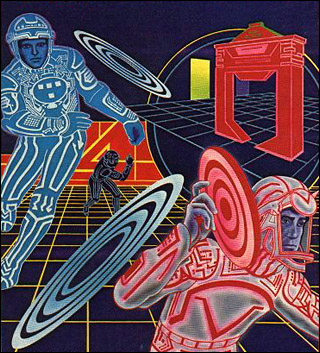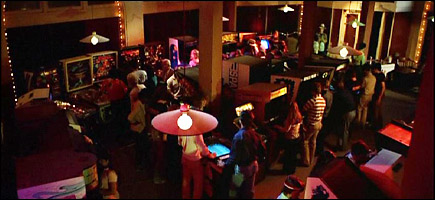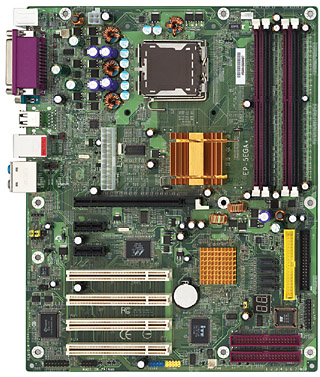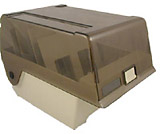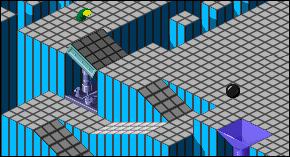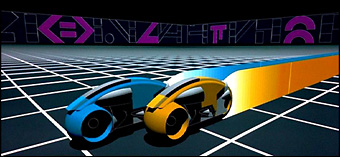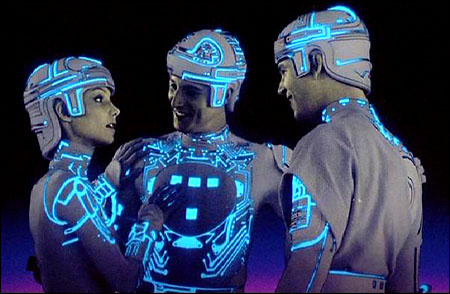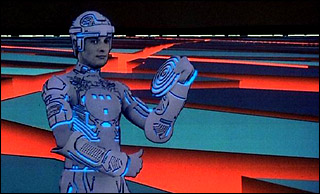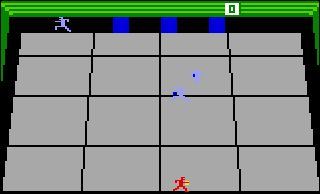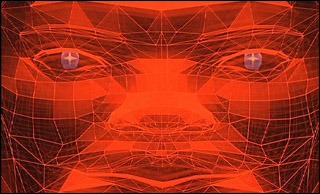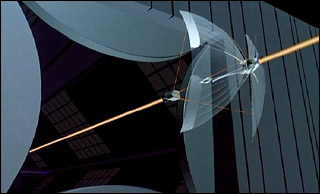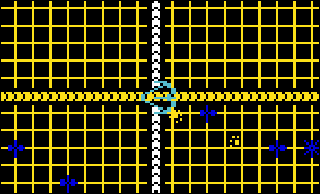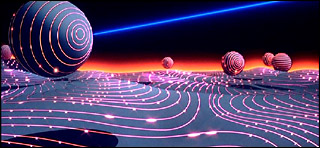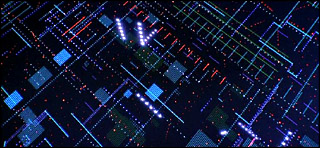
Steven Lisberger and Bonnie MacBird, 1982
Premise
Evaluation
Commentary Tron opens in an arcade. Man, remember arcades? I was a kid during the arcade boom in the first half of the 1980s and went to them all the time — it was the big social activity of the day, going with your friends to the arcade and blowing a couple of dollars' worth of quarters on Pengo and Food Fight.
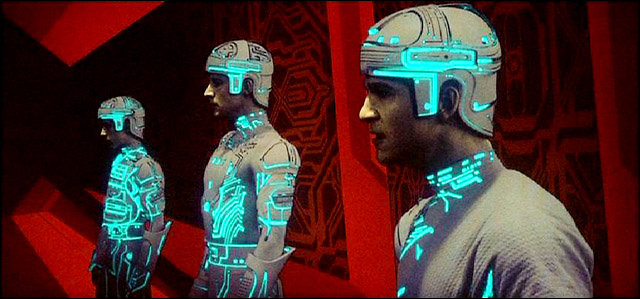 I've been thinking about why Tron's mise en scène resonated so much with me. I think that Tron defined an aesthetic for the dawn of the computer age that's very much in tune with my own associations — and that's important to me, because the dawn of the computer age is where I spent my childhood.
The same thing goes for the vocabulary. As ridiculous as it now seems to have a "program" named "RAM" throwing a "disk" around — sort of like me calling myself Office and throwing a tiny house at people — it does capture an interesting moment in the transformation of our culture from one in which virtually no one had a computer at home
Video games, too, were more futuristic in the early '80s than they are now. Looking at the popular games of today, one says "oh, look, football" or "oh, look, crime." A movie based on the modern video game aesthetic would look like an hour and a half of ESPN, or in the case of the crime games, an hour and a half of... well, I guess that'd be ESPN again. Right now we're in an unfortunate phase in which game designers aim for photorealism but fall short: it's the worst of both worlds, as the results are both unconvincing and ugly. But when I was a kid, game designers knew very well that they didn't have a prayer of achieving photorealism and so didn't try. If today's games try to crawl as far as they can into the "representation" corner of Scott McCloud's famous pyramid, 1980s games staked out their territory over on the right, on the "iconic" side, and in the case of works like Qix and Tempest and Vectron, up into the realm of abstraction as well. McCloud points out that iconic forms can be much more involving than more realistic ones, and that was certainly my experience: I spent much of my youth in the cool, clean, colorful world of pixels and vectors. So Tron's geometric citadels and abstract landscapes felt like home to me.
The frame I captured to show off the tinting has Yori in it, and she is worth a paragraph of her own. The filmmakers made a very interesting decision where Yori was concerned: they didn't tart her up. The male programs wear helmets so you can't see their hair; Yori wears a helmet so you can't see her hair. The males wear head-to-toe armor with glowing circuitry; Yori wears head-to-toe armor with glowing circuitry. And somehow this ends up being sexier than if she'd been running around with her midriff bare and her long blonde tresses flying free. There's just something very cool about how you can be looking at Yori among other "programs" in the same sort of armor, in a very long shot so that they're little more than specks, with Yori turned away so you can't see her breasts, and you can still instantly pick out that she's the girl. Dress her up like all the others, but you can't escape the fact that wimmins is diffurnt. It is funny to realize that you are wired to respond to cues you weren't even conscious of. "Whoa, check out the center of gravity on her!" But back to games. As I mentioned in my first article, even thought I didn't see Tron until 2003, elements of it were familiar to me because I spent so many hours of my childhood playing the Intellivision games based on the movie. It was neat to see things like the Master Control Program and the Solar Sailer brought to life, but above all, I got a kick out of the sequences in which Tron is chucking his disc around. I spent so much time playing Tron Deadly Discs that to an extent you could say that it was the only sport I was really good at. If only it had actually, y'know, existed. So watching live-action Tron Deadly Discs was a treat. Now if only Electronic Arts would repackage Tron Deadly Discs as a two-player console game. It'd have another Madden on its hands. Someone needs to get on this.
One last thing. One of the most interesting aspects of Tron, certainly an element I'd emphasize if I were writing about this for a seminar, is the way that it links the utopian world of the free system to the real modern landscape. To wit:
But of course that utopian last shot is not utopian in real life, not at street level: it is the smoggy sprawl of metro Los Angeles. Even from above, that basin full of lights doesn't automatically make you go "ooh pretty" the way it does in Tron; in Koyaanisqatsi, for instance, such scenes are intended to produce a shudder. Interestingly, Tron does include one dystopian image, a long shot of the Encom office where Alan works:
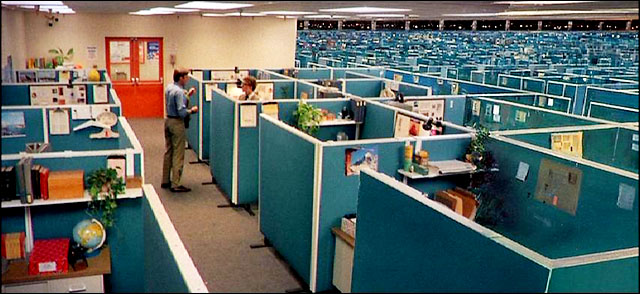 True, this isn't exactly subtle, and the line between the matte painting and the real cubicles is a little too visible, but I thought it made for some pretty hilarious satire. But then I got to thinking. This is a movie that closes approvingly with Los Angeles sprawl. This is also a movie that closes approvingly with Flynn not shutting down Encom, not turning it into a "free system," but simply pulling off a coup d'etat and becoming head of this corporate behemoth, complete with private helicopter. So maybe the sea of cubicles isn't meant to be satire. Maybe the filmmakers thought the cubicles were cool. END OF LINE
Return to the Calendar page! | |||||||||||||||||||||||||||||||

